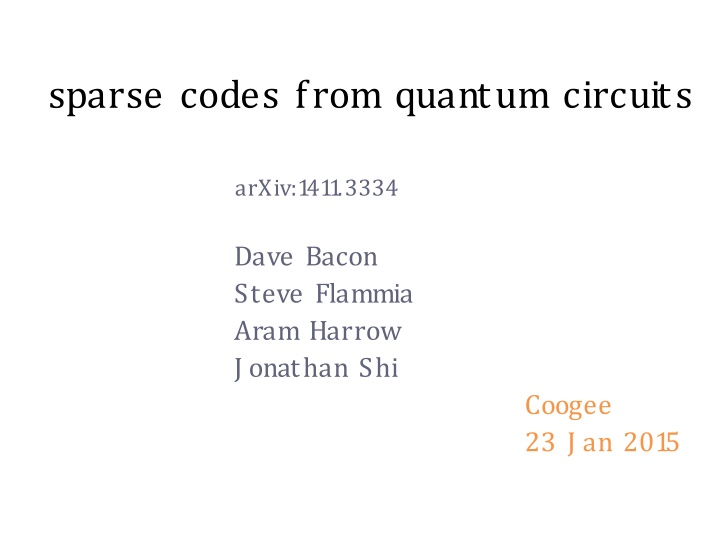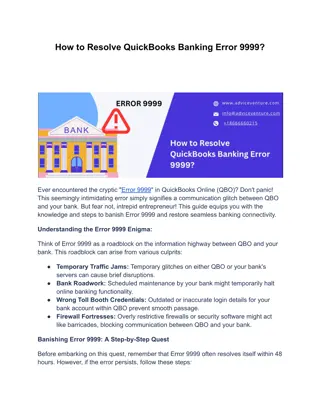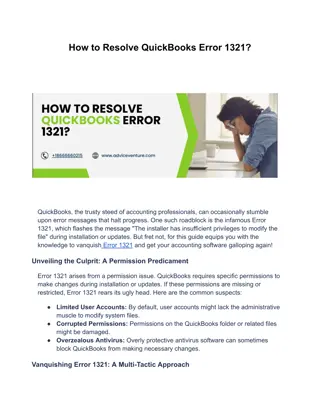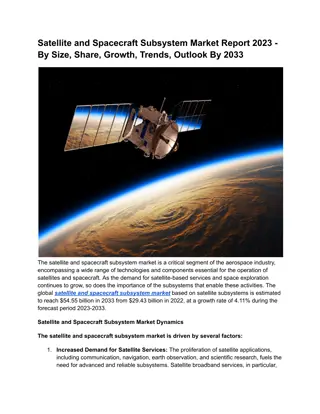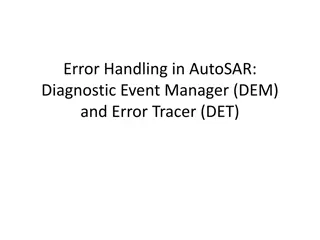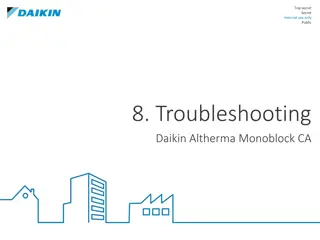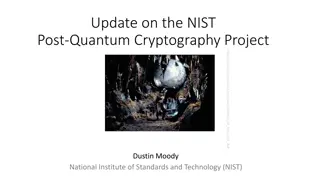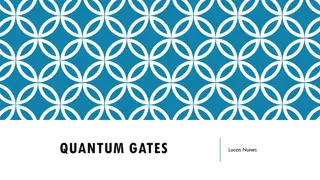Quantum Error-Correcting Codes and Subsystem Codes
Quantum error-correcting codes (QECC) play a crucial role in protecting quantum information from errors. Stabilizer codes with fault-tolerant error-detecting circuits can lead to the construction of resilient subsystem codes. These codes involve encoding logical qubits into physical qubits and error correction mechanisms. Subsystem and gauge codes offer advantages like sparsity, simpler decoding, and improved error thresholds. The structure of these codes includes stabilizer groups, logical groups, and gauge groups that interact to protect quantum information effectively.
Download Presentation

Please find below an Image/Link to download the presentation.
The content on the website is provided AS IS for your information and personal use only. It may not be sold, licensed, or shared on other websites without obtaining consent from the author.If you encounter any issues during the download, it is possible that the publisher has removed the file from their server.
You are allowed to download the files provided on this website for personal or commercial use, subject to the condition that they are used lawfully. All files are the property of their respective owners.
The content on the website is provided AS IS for your information and personal use only. It may not be sold, licensed, or shared on other websites without obtaining consent from the author.
E N D
Presentation Transcript
sparse codes from quantum circuits arXiv:1411.3334 Dave Bacon Steve Flammia Aram Harrow J onathan Shi Coogee 23 J an 2015
QECC [n,k,d] code: encode k logical qubits in n physical qubits and correct errors on <d/2 positions. [n,k,d,w]: ...using a decoding procedure that requires measurements of w qubits at a time. w=O(1) LDPC (low-density parity check) Classically, possible with k, d = (n). WWSD principle qLDPC
qLDPC? k d n1-1/D in D-dim random w n hyper bolic GL 14 O(n) TZ 09 BH 14 w n1/2 2-d gauge B 10 TZ +us kd2/(D-1) n for stabilizer D us toric code O(1) hyperbolic FML 02 dim d O(n) O(n0.3) O(n1/2) O(n1-1/D- ) O((n log(n))1/2) O(n1- )
main results More general theorem: Given an [n,k,d] stabilizer code with a size-S Fault-Tolerant Error-Detecting Circuit we can construct an [n =O(S), k, d, w =O(1)] subsystem code. Main Theorem: Given an [n,k,d] stabilizer code with stabilizer weights w1,..., wn-k, we can construct an [n , k, d, w =O(1)] subsystem code with n = O(n + iwi). Also needed: New F-T E-D circuit for measuring a weight-w stabilizer using O(w) gates. Subsystem codes exist with k=1, w=O(1),
stabilizer codes S = subgroup of {I, X, XZ, Z}n codespace V = {| : s| =| for all s S} Paulis anticommuting with some s S are detected logical operators commute with all of S 3-bit repetition code S = <ZZI, IZZ> = <I Z Z, Z Z I> V = span{|000>, |111>} logical operators <XXX, ZII> 4-qubit code, distance 2 stabilizer generators logical qubit 1 logical qubit 2 XX XX ZZ ZZ ZI ZI XX I I IZ IZ I I XX
subsystem/gauge codes Replace some logical qubits with gauge qubits: Like logical qubits: Commute with stabilizers and errors. Contents can be arbitrary for logical code states. Like stabilizer qubits: Don t care about preserving. Can (and should) measure during decoding. Advantages: sparsity, simpler decoding, (sometimes) better thresholds 4-qubit code, distance 2 stabilizer generators. logical qubit. gauge qubit. XX XX ZZ ZI ZI ZZ I I ZZ XX I I XI XI
structure of subsystem codes Paulis Gauge group G {I, X, XZ, Z}n. Center is stabilizer group: S Z(G)/{ 1} Normalizer is logical group: L N(G)/S X1 X2 ... Xn Z1 Z2 ... Zn 4-qubit code gauge generators XI XI ZZ I I ZZ ZZ I I ZZ IX IX XX XX stabilizer subgroup generated by stabilizers logical X operators gauge X operators errors logical Z operators gauge Z operators ZI ZI XX I I logical group generated by
From Codes to Circuits to Codes Again Begin with a stabilizer code of your choice 00 0 11 1 Write a quantum circuit for measuring the stabilizers of this code. time data input postselected measurement ancilla preparation
From Codes to Circuits to Codes Again Begin with a stabilizer code of your choice 00 0 11 1 Write a quantum circuit for measuring the stabilizers of this code. Turn the circuit elements into input/output qubits
From Codes to Circuits to Codes Again Begin with a stabilizer code of your choice 00 0 11 1 Write a quantum circuit for measuring the stabilizers of this code. Turn the circuit elements into input/output qubits Add gauge generators via Pauli circuit identities.
From Codes to Circuits to Codes Again Begin with a stabilizer code of your choice 00 0 11 1 Write a quantum circuit for measuring the stabilizers of this code. Turn the circuit elements into input/output qubits Add gauge generators via Pauli circuit identities.
From Codes to Circuits to Codes Again Begin with a stabilizer code of your choice 00 0 11 1 Write a quantum circuit for measuring the stabilizers of this code. Turn the circuit elements into input/output qubits Add gauge generators via Pauli circuit identities.
From Codes to Circuits to Codes Again Begin with a stabilizer code of your choice 00 0 11 1 Write a quantum circuit for measuring the stabilizers of this code. Turn the circuit elements into input/output qubits Add gauge generators via Pauli circuit identities.
From Codes to Circuits to Codes Again Begin with a stabilizer code of your choice Write a quantum circuit for measuring the stabilizers of this code. Turn the circuit elements into input/output qubits Add gauge generators via Pauli circuit identities This defines the code Bravyi 2011 does something similar with generalized Bacon-Shor codes
Properties of this Construction Circuits as linear operators preserving the code space V is an error-detecting circuit General condition: V is E-D iff
Properties of this Construction E Circuits as linear operators preserving the code space Gauge equivalence of errors: Apply gauge operators
Properties of this Construction Circuits as linear operators preserving the code space Gauge equivalence of errors: Squeegee lemma: using gauge operations, we can localize errors to the initial data qubits
Stabilizer and Logical Operators Spackling: like squeegee, but you leave a residue Spackling of logical operators gives the new logical operators Spackling of stabilizers on the inputs and ancillas are the new stabilizers Everything else is gauge or detectable error what about distance? *even/odd effect means that circuits wires must have odd length
Code Distance and Fault Tolerance For most error-detecting circuits, the new code is uninteresting (i.e. has bad distance). Theorem: If we use a fault-tolerant circuit then we preserve the code distance Fault tolerance definition: for every error pattern E, either VE = 0 or there exists E on inputs s.t. V E =VE and |E | |E|. Idiosyncratic constraints: Circuit must be Clifford (so no majority vote) No classical feedback or post-processing allowed However, we only need to detect errors
Fault-Tolerant Gadgets Use modified Shor/DiVincenzo cat states Build a cat, and postselect not fault tolerant Redeem this idea by coupling to expanders constant-degree expanders exist with sufficient edge expansion to make this fault tolerant data cat ancilla
expander gadgets data qubits {1, ..., n} cat qubits V, |V|=n ancilla qubits E Recipe: multiple-CNOT from each v to corresponding data qubit and all incident edges. Requirement: Edge expansion 1 means X errors on cat qubits cause more errors on ancillas. Corresponds to classical ECC with energy barrier .
Wake Up! Created sparse subsystem codes with the same k and d parameters as the base code Used fault-tolerant circuits in a new way, via expanders Extra ancillas are required according to the circuit size
Almost Good Sparse Subsystem Codes Start with an [n0,1,d0] random stabilizer code (so that d0=O(n0) with high probability) Concatenate this m times to get an [n0m,1,d0m] code Stabilizers: n0jof weight n0m-j+1. Total weight m n0m+1 Apply Theorem 1 with m = (log n)1 /2 Sparse subsystem codes exist with d = O(n1- ) and = O(1/ log n). _ _ _ _ Best previous distance for sparse codes was d = O( n log n ) by Freedman, Meyer, Luo 2002 ______ *Thank you Sergei Bravyi!
Spatially Local Subsystem Codes Without Strings Take the circuit construction from the previous result Using SWAP gates and wires, spread the circuit over the vertices of a cubic lattice in D dimensions Let n=LD be the total number of qubits Local subsystem codes exist with d = O(LD-1- ) and = O(1/ log n). _ _ _ _
Compared to Known Bounds Local subsystem codes in D dimensions d O(LD-1) Our code: d= (LD-1- ) Best known local stabilizer codes: d=O(LD/2) Local commuting projector codes kd2/(D-1) O(n) Our codes: kd2/(D-1)= (n) (use the hypergraph product codes and our main theorem) * = O((log n)-1/2) Bravyi & Terhal 2009; Bravyi, Poulin, Terhal 2010; Tillich & Z mor 2009
Conclusion & Open Questions Showed a generic way to turn stabilizer codes into sparse subsystem codes New connection between quantum error correction & fault-tolerant quantum circuits What are the limits for sparse stabilizer codes? Self-correcting memory from the gauge Hamiltonian? Efficient, fault-tolerant decoding for these codes? Improve the rate? (Bravyi & Hastings 2013) Extend these results to allow for subsystem codes? Holography? ??? See arxiv:1411.3334 for more details!
